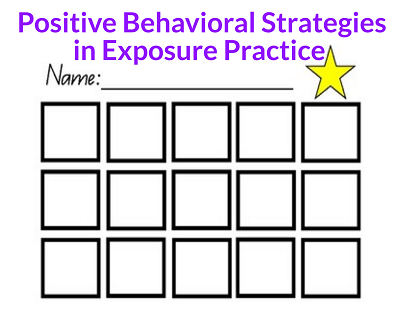Positive Behavioral Strategies in Exposure Practice
Positive Behavioral Strategies in Exposure Practice

The use of positive behavioral strategies in the treatment of anxiety and comorbid behavior disorders is incredibly helpful during therapy sessions. Whether the child is practicing exposures or destroying the therapy room, these strategies can help therapists to increase therapeutic time and decrease frustration for all involved. Just remember the basic principle of consequences in operant conditioning (a la B. F. Skinner):
1. Reinforcers increase behavior.
2. Punishments decrease behavior.
3. Positive consequences add something.
4. Negative consequences take something away.
That is, positive reinforcers (e.g., stickers and prizes) or negative reinforcers (e.g., fewer arguments) can be powerful consequences to increase desired behaviors in session. On the flip side, positive punishments (e.g., extra homework) or negative punishments (e.g., loss of screen time) can really help to decrease those problem behaviors such as destruction and aggression.
Here are 3 useful strategies for your next therapy session:
1. Rewards (Positive Reinforcement)
We’ve all used rewards before, but believe it or not, when used correctly, rewards are really rewarding! For younger clients, a simple sticker chart with clear expectations can work wonders. Remind the client at the start of each session, “Every time you finish an exposure from your hierarchy, you will earn a sticker! When you get to 5 stickers, you’ll earn a prize from the treasure box!” Don’t forget that rewards can work with teens and even adults too. Try “When you practice your coping strategy every night before bed, you can earn 15 minutes of extra time on Instagram!” Be sure that the expected behavior is clear, the reward is as immediate, and the client is bought in. No 3-year-old wants to earn tickets to Bruce Springsteen and most teenagers wouldn’t work for a gold star.
2. Labeled Praise (Positive Reinforcement)
We also use praise a lot. “Great job!” and “Nice work!” are wonderful to hear, but they don’t maximize the opportunity to label the behavior and increase something we really want to see. When clients are practicing exposures, it’s good practice to praise their bravery or their distress tolerance. “You are feeling worried and you’re still holding your hand out for the dog to sniff! I’m so impressed by your bravery today.” We might also decide to praise other appropriate behaviors in the therapy office. “Thanks for coloring on the paper today!” and “Great work using a calm voice,” are a few more favorites. Again, be sure the praise is clear, specific, and client-appropriate. I wouldn’t say “Thanks for keeping your body calm” to an adult just like “I appreciate that you expressed your emotions so clearly” wouldn’t work for a Kindergartener.
3. Active Ignore (Negative Consequence)
This is the ultimate skill for anyone hoping to get rid of a behavior that is annoying, but not aggressive or destructive. It can be used for whining, tardiness, running, hiding, or even avoiding therapy homework! The goal is to remove any and all attention from the behavior we want to see less of. Yes, that includes yelling, negotiating, arguing, and lecturing about the problem behavior. Active ignoring for behavior during session requires that all attention (eye contact, body posturing, discussion) is removed while the client is engaging in the problem behavior. For example, if a teen is interrupting a parent during session, actively ignore them until they are able to wait their turn to speak. For younger children, actively ignore a separation-anxiety induced tantrum by presenting and modeling coping strategies until the child is able to calm down. After the negative behavior stops, or whenever the client shows a positive opposite behavior (e.g., waiting patiently, calm voice), use a labeled praise immediately! For example, “Thanks for calming down so quickly even when mom left the room! You are so brave.”
4. Time-Out (Negative Consequence)
The use of these three strategies can really help therapists to increase exposure practice and decrease problem behavior in the office, and can help parents and caregivers do the same at home! Tried one but wasn’t sure if it worked? Contact me @drvivyan on Instagram or Twitter to talk it through. Need extra support? Make an appointment with a licensed mental health provider.












